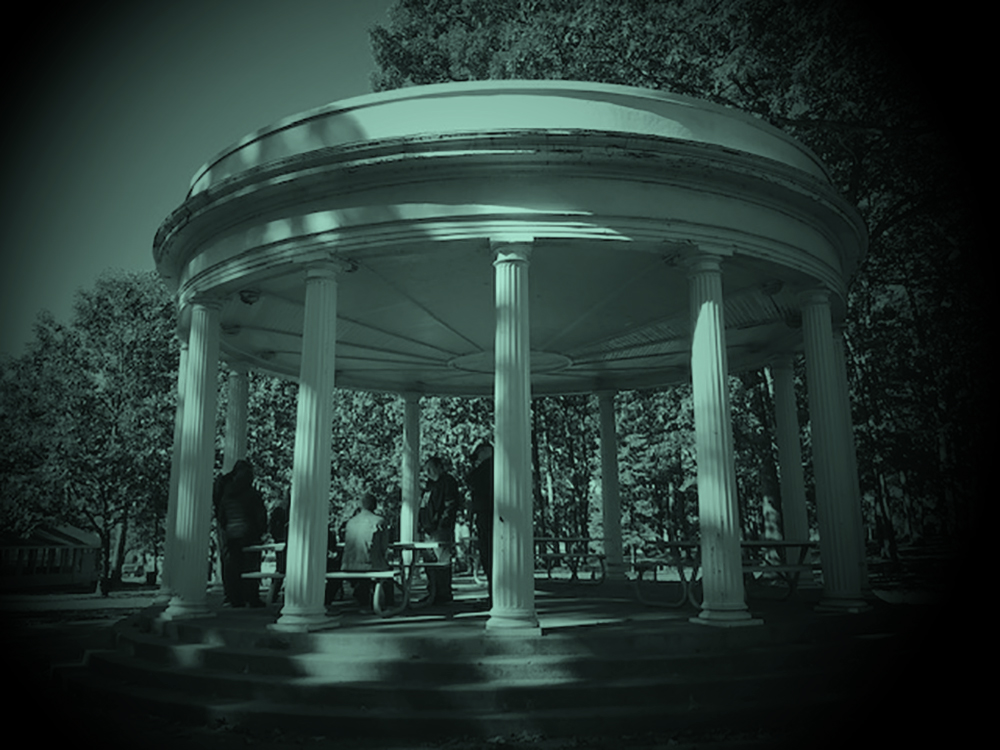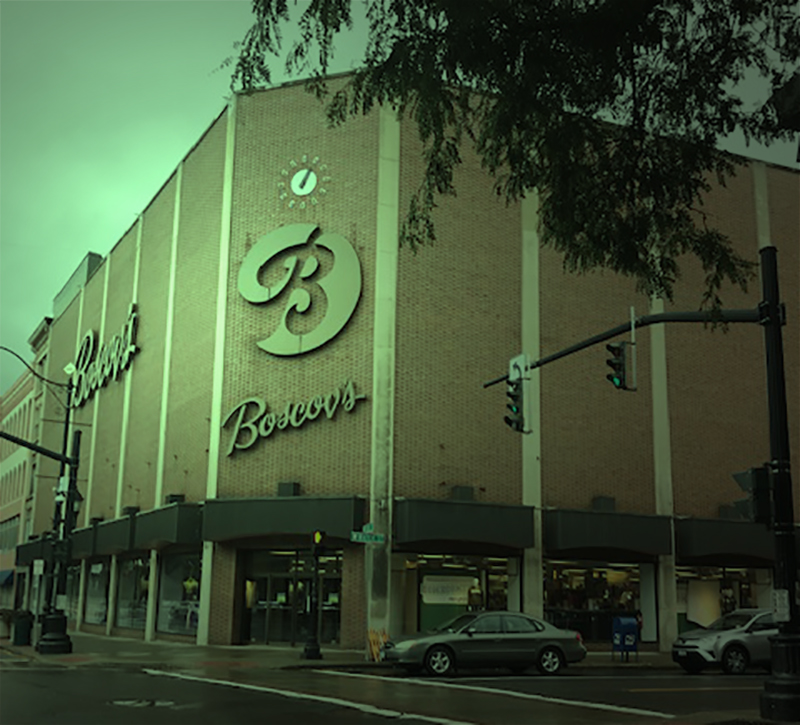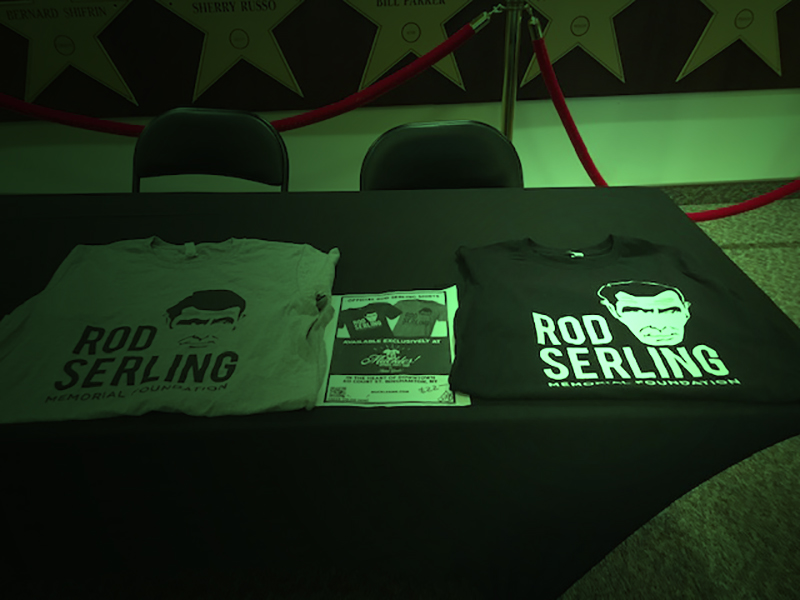There is no more fitting to end the first night of a Twilight Zone conference than finding out my hotel is condemned. Condemned for about a year, according to the caretaker, who seemed more bothered by my phone call than I was by not having a place to sleep for the night. He could tell me nothing, except that the building had been vacant for a year, leaving me with more questions and my overnight bag on a dimly lit street corner in a sleepy town. The hotel was supposed to have tall glass windows embedded in a historic facade in the city center, flanked by two stone lions on either side, right in the center of downtown Binghamton. It was, instead, condemned, forcing me to drive to the nearest motel to find a few hours of sleep before heading to day two of the conference.
The parks, the timeless downtown buildings and waterways, however, call to mind exactly what would attract a man like Rod Serling. Like a tired executive trying to relive his unencumbered childhood, the city is unchanged, stuck in a time that’s long gone.
This downtown area is part of the historic district of Binghamton, New York, dating back to the mid-1800s, when the Erie Canal expedited business and manufacturing in upstate regions via the Chenango and Susquehanna Rivers. The town is about 200 miles from New York City, a three-and-a-half-hour drive through wet mountain valleys and green hills, passing a few rest stops and small towns until you reach the Binghamton metro area, with its large state university. Locals will tell you to try a spiedie, the local version of a cheesesteak, and give you the best spots for kayaking; I did neither.
I had just come from the Forum Theatre, four short blocks from that ill-fated “historic hotel,” where I’d spent the day listening to fans of the creator of The Twilight Zone, a six-time Emmy winner, Peabody winner, and author of eleven books and countless scripts, Rod Serling. The third annual Serling Fest, run by the Rod Serling Memorial Foundation, included panels on current media inspired by Serling’s work, a discussion with his daughters and colleagues, and an in-depth workshop on musical cues in Twilight Zone episodes. I’m a mid-century history buff and the conference was recommended to me by a friend who had just written a book on the era, and was speaking later in the weekend at Rod Serling’s old high school.
It all started just a few hours into the morning at the Recreation Park gazebo, peeling and splintered from time. The park, miles from the state university that set up shop in Binghamton in 1950, and just over the bridge from the old downtown, was a perfect spot to enjoy a coffee on a chilly October morning. Just one family ran wild through the playground and the park house was locked, indicating the busy season had ended for the year. The whole place was quiet, really quiet, except for a few groups of shuffling passers-by beginning to congregate around the park’s carousel house.

Binghamton may have been a boom town in Serling’s day, but this particular weekend it carried the feeling that everyone got up and left one day, and hadn’t returned yet. In fact, Recreation Park Carousel and the nearby gazebo both have starring roles in “Walking Distance” and if you squint, you feel as if you do, too.
“We’re trying to get the door open,” a man smiled from within the group standing directly around an unlatched old window. A woman piped up next: “If we could reach the door from here, we could unlock it.” It was soon discovered that the 1925 carousel would be open at noon — just for this event — and we could all ride for free then, off-season be damned.
Star Wars theme parks, comic book conferences, magician’s lounges — my passport reveals quite a few fandom conventions, but this had to be the quietest clan of sci-fi fans I’d ever encountered. Gone was the bravado of an attendee at Comic-Con, happening the very same day, miles away in New York City. Twilight Zone fans carried piles of books in their arms, referencing unseen episodes lost to television mythology; they worked silently in tandem on a custom-created Twilight Zone jigsaw puzzle. “This has to be one of the best weekends of my life,” a man not much older than a college-grad announced during a Q&A session late in the weekend.
The fans, about 200 strong, filled downtown Binghamton, but beyond this tongue-tied troupe, there were not many revelers in the historic district. Where was everyone in Binghamton?
Turns out, most left in the 1950s, shortly after Serling himself packed up and went to war. Flush with cash and opportunity, turn-of-the-century Binghamton was home to manufacturing plants and business by waterway, like the International Time Recording Company, which would eventually become the very first campus of IBM. So prosperous was life in this upstate enclave that it quickly became known by two whimsical names: the Parlor City, for the decorative sitting rooms of the prominent mansions all over town, and Carousel Capital of the World, for the six gorgeous carousels bequeathed by businessman George F. Johnson, the local pioneer of Binghamton’s best years. Green spaces, good schools, job opportunities…when Serling’s family made the move from Syracuse in the mid 1920s, there could be no better place to raise baby Rod and the family. What of it today, though, quiet and aging?
“It’s funny how many memories you connect with a place,” says Martin Sloan, the lead character in “Walking Distance,” a Twilight Zone episode in which a sullen New York business executive longs for the simple life in the hometown of his childhood (it’s a trope you’ll also see in episodes like “A Stop at Willoughby” and “The Trouble With Templeton”). “I always thought if I ever came back here everything would be all changed. No, nothing recognizable. Instead, it’s just as if I’d left yesterday.” That weekend, I wondered what Serling would think about Binghamton now.
Nick Parisi’s book Rod Serling: His Life, Work and Imagination dedicates a chapter to the connection between city and Serling. “In the strangely brittle, terribly sensitive makeup of a human being, there is a need for a place to hang a hat or a kind of geographical womb to crawl back into, or maybe just a place that’s familiar because that’s where you grew up,” Serling said. “Everybody has to have a hometown. Binghamton’s mine.”

Was this still the town his childhood dreams were made of? What would he say of the desolate downtown hotel? Would he delight, or be saddened that Boscov’s, the inspiration for Twilight Zone episode 34, “The After Hours,” is still the only shopping in the center of town? The Forum sits on the location of the original vaudeville theatre that opened in 1919, but after a handful of renovations, the building has been nearly completely replaced. The high school where Rod caught the theatre bug is still here, as is the house he grew up in, just blocks from the Recreation Park Carousel and the gazebo, where Serling’s name appears on a circular gold plaque.
Once the panels came to a close, the event was like watching Netflix with a hundred of your closest friends. I settled in with a snack for back-to-back hours of retro TV, specifically the three Twilight Zone episodes starring actor Bill Mumy, and the 90-minute pilot of Night Gallery, Serling’s lesser-known and more macabre program. Mumy is best known for the 1961 Twilight Zone episode “It’s a Good Life,” about a young boy with unusual powers who cuts off technology from his small rural town, keeping its inhabitants under his thumb; the infamous episode has been parodied numerous times, and Mumy reprised his role as Anthony in a sequel, “It’s Still a Good Life.” And of course, there were clips of and conversation about two top fan favorites: “Walking Distance” and “The Monsters Are Due on Maple Street,” the tale of an idyllic suburb torn apart by the promise of the impending unknown. Spending just a few minutes around Recreation Park, you feel like you could be one of those Maple Street dwellers, comfortable watching the leaves turn colors and fall, content to live without the changes spurring on outside developments. Binghamton may have been a boom town in Serling’s day, but this particular weekend it carried the feeling that everyone got up and left one day, and hadn’t returned yet. In fact, Recreation Park Carousel and the nearby gazebo both have starring roles in “Walking Distance” and if you squint, you feel as if you do, too.

“Every writer has certain special loves, certain hangups,” Serling said. “In my case, it’s a hunger to be young again. A desperate hunger to go back to where it all began.”
Of course, Binghamton wasn’t exactly the Willoughby Serling saw it as. By the 1920s, the Ku Klux Klan had been pushed out of New York City and forced to keep residence in Binghamton, a city with lesser support for Jews and Catholics than its urban neighbor. The cigar industry, which had led so many workers to the city, was starting to lose business to cigarettes in the early part of the century, and by then, railroads had made the city’s canal system almost obsolete. Though IBM didn’t officially move headquarters until the 60s, the population began to stagnate and drop in the late 40s; today it hovers around 44,000 residents, nearly half of the population it had before World War II.
The parks, the timeless downtown buildings and waterways, however, call to mind exactly what would attract a man like Rod Serling. Like a tired executive trying to relive his unencumbered childhood, the city is unchanged, stuck in a time that’s long gone. And yet the very technology it piloted decades earlier has launched the world around it. This was a city created for and by progress, and subsequently made barren by that success. “You’ve been looking behind you. Try looking ahead,” says Martin’s dad in “Walking Distance.” But who’s to say we aren’t watching the future of other technology empires? A predecessor to Detroit? Silicon Valley in another decade?
Rod’s memory will always be heavy here. You can see his mural at the high school. In the summer you can ride the carousel. The local Bundy Museum has a library filled with Rod Serling books and treasures, and the Forum Theatre keeps artifacts in the lobby.
His attachment to this place is fitting, giving context to a town that seems to float through time. With the nearby state university growing, there’s hope in a resurgence to Binghamton. Or maybe it will always be the place where Rod Serling tries to go home again, the old City of Parlors, the nostalgic Capital of Carousels, in a place called The Twilight Zone.
